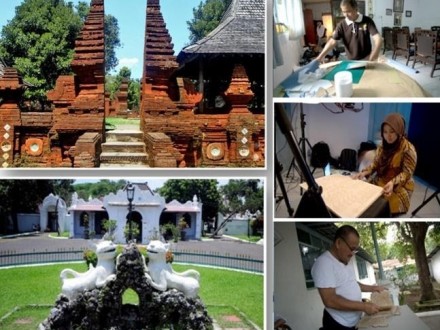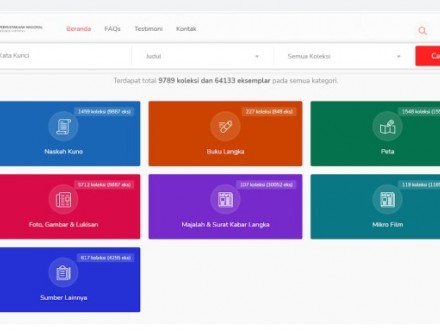Preserving Nusantara Manuscripts and Supporting Sustainable Cities and Communities Development
15 May 2021
Everyone agrees that manuscript is a valuable legacy, written in the past to become a foothold in the present and future. Manuscript has important values as language documents, historical documents and cultural documents. These vital values are the foundation in supporting sustainable cities and communities development. According to the National Library of Indonesia’s Grand Design of Nusantara Manuscripts Management 2020-2029, Indonesia has 121,668 manuscripts scattered throughout the world. Among them, 39,387 are abroad while 82,281 are within the country. The National Library of Indonesia (NLI) acts as the front guard in preserving this cultural heritage.
The Journey of Nusantara Manuscripts Preservation by NLI throughout Indonesia

Figure 1. Manuscripts Preservation at Keraton Kasepuhan Cirebon, West Java
Source: http://preservasi.perpusnas.go.id/
Through the Library Material Preservation Centre, NLI is actively involved in preserving manuscripts throughout Indonesia. The Conservation Team from the Preservation Centre undertakes conservation efforts physically and digitally by transferring media to digital and micro forms. The progress of the manuscript preservation carried out by the Library Material Preservation Centre is captured in the table below:
Table 1. Manuscripts Preservation Throughout Indonesia
|
No. |
Year |
Province |
Number of Titles |
|
1 |
2006 |
West Nusa Tenggara |
74 |
|
2 |
2007 |
Riau Islands |
21 |
|
3 |
2007 |
Aceh |
4 |
|
4 |
2007 |
Bengkulu |
5 |
|
5 |
2008 |
West Nusa Tenggara |
7 |
|
6 |
2008 |
Riau Islands |
3 |
|
7 |
2008 |
East Java |
5 |
|
8 |
2008 |
South Sulawesi |
13 |
|
9 |
2009 |
West Sumatera |
30 |
|
10 |
2009 |
West Java |
56 |
|
11 |
2010 |
Central Java |
14 |
|
12 |
2012 |
Central Maluku |
56 |
|
13 |
2013 |
South East Sulawesi |
16 |
|
14 |
2013 |
Bali |
210 |
|
15 |
2013 |
West Java |
55 |
|
16 |
2013 |
North Sumatera |
30 |
|
17 |
2014 |
West Java |
41 |
|
18 |
2015 |
West Java |
47 |
|
19 |
2015 |
Jambi |
13 |
|
20 |
2015 |
Central Java |
99 |
|
21 |
2015 |
South Kalimantan |
171 |
|
22 |
2015 |
Jambi |
65 |
|
23 |
2016 |
West Sumatera |
125 |
|
24 |
2017 |
Riau |
138 |
|
25 |
2018 |
Bali |
230 |
|
26 |
2018 |
East Jawa |
250 |
Source:
Hendrawati, T. 2018. Digitalisasi Manuskrip Nusantara Sebagai Pelestari Intelektual Leluhur Bangsa. Media Pustakawan. Vol. 25 No. 4.
After preservation, a copy of the Nusantara Manuscript, which has been converted into digital format, will be stored in NLI and another copy will be kept by the owner.
Khastara Website: 1 Digital Data of Nusantara Manuscripts
NLI has a vision of “1 Digital Data of Nusantara Manuscripts”. This vision is the basis for digitising the Nusantara Manuscripts and providing the maximum access for the public to utilise those cultural documents. With this vision, NLI has created a website called Khastara (Khasanah Pustaka Nusantara). Khastara provides the most complete digital content in Indonesia, namely 9,789 collections and 64,133 copies in all categories. The content in the categories can be broken down further as follows: 1,459 manuscripts (9,887 ex), 227 rare books (848 ex), 1,548 maps (1,551 ex), 119 microfilms (11,653 ex), 5,712 pictures & paintings (5,887 ex), 107 rare magazines & newspapers (30,052 ex), and 617 other sources (4,255 ex).

Figure 2. Khastara Website
https://khastara.perpusnas.go.id/
This portal displays detailed collection information for free and supports the PDF Flip format for easy reading. Users only need a Google account to log in immediately. To date, the total number of visitors who have accessed the portal is 755,613. These visitors come from various backgrounds such as students and researchers who are doing research and manuscript activists who intend to introduce the richness of Indonesian manuscripts to the young generation.
The Essence of Preservation of Nusantara Manuscripts in the Future
In order to support the 11th goal of SDGs in the Library Sector (Sustainable Cities and Communities), NLI builds synergies with various parties. For instance, it organised a webinar entitled “1 Digital Data of Nusantara Manuscripts” in March 2021which provided much inspiration. Among the participants, A.A.G.N Ari Dwipayana (Coordinator of Presidential Staff and Head of Puri Kauhan Ubud Foundation) introduced a new family-based approach in preserving manuscripts that are still scattered in the community. He also said that the preservation of manuscripts did not end with digitisation but the process continued with script transfer, language translation, publication, discussion and scientification. This is to ensure that the Nusantara Manuscripts can be utilised and can contribute significantly in supporting sustainable cities and to the development of communities in the future. The Head of NLI, Mr Syarif Bando, said that in the future, there must be a commitment to make sure that the library is not only a guardian institution for civilisation. Through historical evidence stored in libraries, Indonesia must be able to create new theories that can become evidence of the nation’s progress.